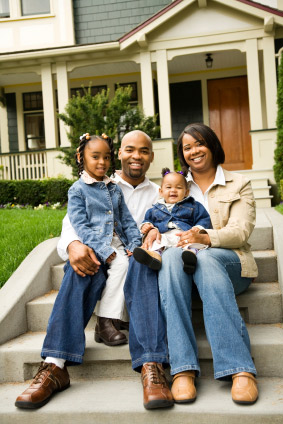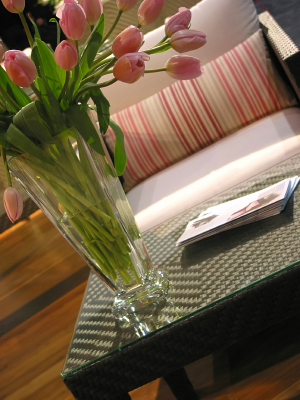 |
|
|
 |
 |
|
When
you set out to achieve a goal in feng shui, whether it is to increase
productivity in the office, invite romance into the bedroom, balance
yin and yang energy in the home or create a more peaceful environment
for your family, the basic premises that you are working with are
harmony and balance. When people are in tune with their environments,
they tend to be better adjusted, healthier, happier, more productive,
and overall more content with their spaces and their lives. Seeking
this out is natural.
 The
goals that are set in life often reflect not only where we would like
to go, but the places we are trying to leave behind. This is part of
why feng shui is so popular – it provides a very tangible and concrete
way of establishing a sense of harmony within our spaces and ourselves.
Clearing out the clutter (a very common starting point in feng shui
renovations) is a way of cleaning out the past. The use of symbolic
items in the home to correspond with the Bagua map also points us
toward the future and where we would like our life to lead us. The
goals that are set in life often reflect not only where we would like
to go, but the places we are trying to leave behind. This is part of
why feng shui is so popular – it provides a very tangible and concrete
way of establishing a sense of harmony within our spaces and ourselves.
Clearing out the clutter (a very common starting point in feng shui
renovations) is a way of cleaning out the past. The use of symbolic
items in the home to correspond with the Bagua map also points us
toward the future and where we would like our life to lead us.
Cultivating harmony
and balance within the home is not the act of specifically looking to
bring those two aspects into the home as much as it is determining what
kind of environment will support and enhance the lives led by those
living there. What will bring peace to one may not affect another in
the same way. Rather than look at peace and harmony as destinations,
view them as by-products of living in a space that is nourishing and
supportive to one's soul – as well as one's goals.
|
|
 |
 |
One
of the original purposes of feng shui was to determine house placement.
In fact, selecting locations for home building and for burial were
among the two most significant aspects of early feng shui. Internal
decorations and item placement in the home are considered a secondary
art  form
by some. When building a house from scratch, you have the best starting
point for feng shui in that you can specifically work with the
placement of your home to ensure positive energy flow throughout the space. form
by some. When building a house from scratch, you have the best starting
point for feng shui in that you can specifically work with the
placement of your home to ensure positive energy flow throughout the space.
Long before
you're looking at house plans, you are looking at properties. This is
an important place to start as the principles of feng shui have strong
assertions as to where NOT to build your home. You should not build
your home close to an extremely yin or extremely yang location. Yin
locations would include hospitals, places of worship, and cemeteries.
Feng shui is especially specific about not building adjacent to burial
sites. Yang places would include schools, prisons, and power plants.
Ideally, a home would
be built on a site with balanced yin and yang principles. In cases
where it is unavoidable, there are changes that can be made in home
layout, landscaping design, etc. to help balance the energies. If you
already live in a space that you realize is overly yin or yang, there
are changes you can make in your existing home as well.
|
|
 |
 |
Pink,
a color representative of the fire element, is also the color that feng
shui associates with romance. Pink is also a very soothing color,
without the risk of being tiring or depressing. Pink would
traditionally be used in the southwest (love and marriage) areas  of
the home. This also works well within the productive cycle of the five
elements. As fire creates earth, having the pink fire element in the
southwest earth area of the home is a growth-oriented and nourishing
elemental interaction. of
the home. This also works well within the productive cycle of the five
elements. As fire creates earth, having the pink fire element in the
southwest earth area of the home is a growth-oriented and nourishing
elemental interaction.
Signs you have
too much pink in your home would be a general sense of floating through
life (and not in good way) or if the inhabitants of your pink room or
home seem to live in a little fantasy world all of their own! If the
reverse is true and there isn't enough pink in the home, consider rose
quartz, flowers, candles or fabrics to create a little more romance and
fire in your home and in your life.
To incorporate pink with other colors in the home, consider the following combinations:
Pink (pale) and black: These
fire and water colors have a very elegant and classy feel to them when
combined. They also create movement and tension in a room, which is
positive in that it fosters growth.
Pink (bright) and orange: Orange increases the fire element involved, making "hot pink" a literal description!
Pink and green: The combination of fire and wood creates strength and activity in the love area of the home.
|
|
 |
|
|
|
 |
|
In This Issue:
|
|
 |
|
Contact Me
|
Jane Smith

888-888-8888
Website
|

|
|
Exhaustive Cycle
|
|
The
exhaustive cycle in feng shui is the opposite of the productive cycle.
The exhaustive cycle focuses on which elements exhaust, or reduce, the
other element. When wood is burned to create fire, wood to fire is a
productive relationship, as one creates the other. When fire burns up
wood, the wood is reduced, and it is an exhaustive relationship.
The exhaustive cycle
moves such that fire exhausts earth which exhausts metal which exhausts
water which exhausts wood which exhausts fire. For using this in the
home, elements that are too strong, inauspicious or negative can be
reduced by using the corresponding exhaustive element.
|

|
|
The Element of Earth in Feng Shui
|
|
Earth is considered to
be the most stable of all five elements. In no small part, this is
because earth is our home base – the foundation upon which all life is
built. The earth element is represented by the color yellow and is a
yin (feminine) element. It is said to represent strength, stability,
abundance, reliability and resourcefulness. To bring the earth element
into your home, look to the earth itself: clay (i.e. terra cotta,
pottery, and ceramic), stone, plants and so on. Potted plants in clay
containers are an exceptional way to enhance the earth element, as are
pieces of jade and stone statues.
|
|
 |
